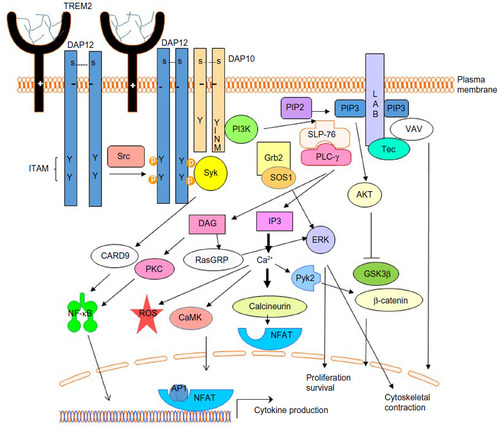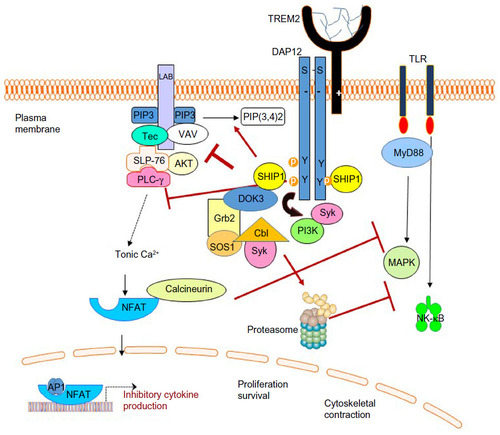Figures & data
Table 1 TREM2 and TYROBP mutations identified in PLOSL
Figure 1 Multimeric or high-affinity ligand-induced TREM2 signaling promotes myeloid cell activation.
Abbreviations: TREM2, triggering receptor expressed on myeloid cells-2; ITAM, immunoreceptor tyrosine-based activation motif; DAP12, DNAX-activating protein 12; Syk, spleen tyrosine kinase; PI3K, phosphatidylinositol-3 kinase; PIP2, phosphatidylinositol-4,5-bisphosphate; PIP3, phosphatidylinositol-3,4,5-trisphosphate; LAB, linker for the activation of B cells; SLP-76, Src homology 2 domain-containing leukocyte protein of 76 kDa; PLC-γ2, phospholipase C gamma-2; Grb2, growth factor-receptor-bound protein 2; ROS, reactive oxygen species; NFAT, nuclear factor activated T cell; SOS1, son of sevenless homolog1; DAG, diacylglycerol; IP3, inositol-1,4,5-trisphosphate; PKC, protein kinase C; RasGRP, Ras guanyl nucleotide-releasing protein; CaMK, calmodulin-dependent kinase.

Figure 2 Monovalent or weak ligand-induced TREM2 signaling is anti-inflammatory.
Abbreviations: TREM2, triggering receptor expressed on myeloid cells-2; ITAM, immunoreceptor tyrosine-based activation motif; SHIP1, SH2 domain-containing inositol phosphatase-1; DAP12, DNAX-activating protein 12; SH2, Src homology 2; PI3K, phosphatidylinositol-3 kinase; Syk, spleen tyrosine kinase; PLC-γ2, phospholipase C gamma-2; MAPK, mitogen-activated protein kinase; TLR, Toll-like receptor; NFAT, nuclear factor activated T cell; IL-10, interleukin-10; LAB, linker for the activation of B cells; SLP-76, SH2 domain-containing leukocyte protein of 76 kDa; Grb2, growth factor-receptor-bound protein 2; DOK3, downstream of kinases 3; SOS1, son of sevenless homolog1.

